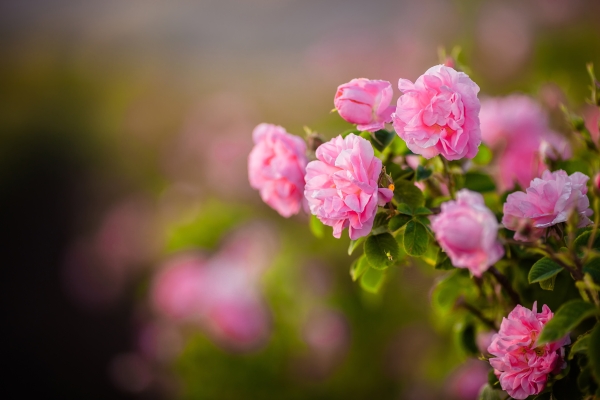Recently, I did an Internet search for the top 10 perfumes of all time and 8 of them were floral-dominate combinations. The other two were the incomparable Chanel N5 and the classic amber Shalimar. Floral aromas have long been the most popular types of fragrances for women and a recent Rutgers University study explains why. In the study, 147 women were randomly broken into three groups. One group received flowers, another candles, and another fruit. Among the woman who received candles, 23 percent didn’t smile, while 10 percent of woman who received fruit didn’t smile. Guess the percentage of women who didn’t smile when they received flowers? 0 percent. Every single woman who received flowers smiled. Science proves it. We love flowers!
Perfumers organize aromas into categories called “facets”. The word, facet means one side of something that is many-sided (like a cut gem). Perfumers are aiming to convey the idea that an aroma has particular aspects, features, dimensions, or characteristics. In perfume formulation, different facets are combined to ensure something is – you guessed it – multifaceted!
The floral facet is broken into sub-categories to differentiate aromas that might generally be described as sweet, rich, flowery, and feminine. No two floral scents are the same because wide varieties of volatile compounds interact to entice just the right pollinator to the blossom. Floral aromas are therefore broken down into sub-facets. Note that I’ll include the botanical name the first time I mention a species for clarity. These are floral sub-facets:
Cool floral aromas are crisp, rosy, refined, and serene. This facet includes cabbage rose (Rosa x centifolia), Damask rose (Rosa x damascena), geranium (Pelargonium graveolens), and palmarosa (Cymbopogon martinii). If you’re thinking to yourself, “Wait! Palmarosa is a grass.” You’re right, but it has a rosy aroma that causes it to be classified in the cool floral category. In perfumery, cool florals are often used to counter the overt sexuality of sensual florals.
Fresh floral aromas are bright, with green, clean-spicy, or light-fruity undertones and include boronia absolute (Boronia megastigma), hyacinth absolute (Hyacinthus orientalis), linden flower absolute (Tilia species), narcissus absolute (Narcissus poeticus), and tagetes absolute (Tagetes minuta). Boronia absolute is interesting because it defies classification. It smells rosy, lemony, and velvety with sarsaparilla-like overtones.
Powdery floral aromas are soft, fine, diffusive, dry, and ethereal. This facet includes cassie (Acacia farnesiana), mignonette (Reseda odorata), mimosa flower absolute (Acacia dealbata), and violet flower absolute (Viola odorata).
Sensual floral aromas are deep, wet, warm, narcotic, heady, creamy, and animalitic with deep fruit or deep wood undertones. The term, animalitic is often used (instead of animalistic) in perfume. It is meant to convey the idea of an animal-like instinctiveness, fierceness, or free-ranging pleasure in life. The sensual floral facet includes champaca (Magnolia champaca), frangipani (Plumeria species), gardenia (Gardenia jasminoides), jasmine (Jasminum officinal var. grandiflorum), jasmine sambac (Jasminum sambac), karo karoundi (Leptactina senegambica), lilac through CO2 production (Syrina species), magnolia (Magnolia grandiflora), orange blossom (Citrus aurantium var. amara), tuberose (Polianthes tuberosa), and ylang ylang (Cananga odorata var. genuina).
Warm floral aromas are honey-like, with hints of hot spice, black tea, hay, or herbs. This facet includes blue lotus absolute (Nymphaea caerulea), broom (Spartium junceum), and carnation (Dianthus species).
As aromatherapists making natural perfumes, we can learn something from perfumers about how to blend opulent floral aromas by understanding how they combine the floral facet with other aroma facets. While we won’t want to use synthetic aromas – as perfumers do – with a few tricks we can make natural floral perfumes our mothers, grandmothers, sisters, aunts, and friends will love. In these floral-forward blend combinations, various other aroma facets are used to highlight, feature, harness, or balance flowers.
Soliflore: Soliflore means “single flower” in French. This type of blend is meant to promote or harness a particular flower like rose, jasmine, magnolia, orange blossom, gardenia, or carnation. Non-flower aromas combine with the single flower aroma to give it a spotlight or to soften its lush overtones. The goal is a scent that is simple, youthful, and pretty without the need to make a statement. Perfumers use a variety of synthetics to concoct soliflores. I find that a base of sweet birch (Betula lenta), black pepper (Piper nigrum), and bergamot (Citrus x bergamia) allow me to both harness (soften) and feature single flower aromas. Cardamom (Elettaria cardamomum) essential oil also softens an overt floral note. It is sweet enough to blend in and disappear while also dampening down the headiness of many flowers.
Floral Bouquet: This type of blend combines a number of different flower oils for an aroma that is extravagant, opulent, intoxicating, gorgeous, and tremendously feminine. No single flower dominates.
Soft Floral: A soft floral is a combination of aromas in the powdery balsamic facet and aromas in the floral facet. In perfumery, perfumers add synthetic aldehydes to flower scents to create soft floral accords. Aldehydes (different from the aldehydes that occur in natural essential oils) are chemical components that give aromas a fizzy, effervescent, fruity, or ephemeral quality. The famous Channel N5 is a classic example. In natural blending, I think you can get a sparkling bubbly feel from a dash of clary sage (Salvia sclarea), white camphor (Cinnamomum camphora), violet leaf, boronia, or bergamot.
Green Floral: In natural aromas, violet leaf adds a particularly pleasing green note to floral aromas. Green florals aim to smell fresh, sharp, and bright. Sometimes galbanum (Ferula galbaniflua) or leafy herbal oils add a deep green, penetrating, and complex depth to the floral facet.
Fresh Floral: When floral aromas combine with citrus essences, the resulting arrangement is light, aerated, flirty, and pretty. Blending a citrus oil with a flower oil is an easy way to get a sumptuous uplifting result. I love ylang ylang with lime (Citrus aurantifolia), rose with bergamot, and jasmine with grapefruit (Citrus x paradisi).
Ambery Floral: A sweet, warm, powdery, and exotic base supports a lush, heady, and floral aroma like gardenia, rose, or tuberose, or a spicy floral like carnation. Combinations of vanilla (Vanilla planifolia), spice, and orange blossom are currently popular.
I hope you enjoyed this overview of the floral facet and floral-forward combinations. If you want information about the 17 different aroma facets and 7 traditional perfumer combinations that could be composed using natural aromas, check out my folio titled, The Language and Categorization of Aroma in the “Folio” section of this website. Make sure to purchase only therapeutic grade essential oils from the suppliers I suggest in the “Recommendations” section.

